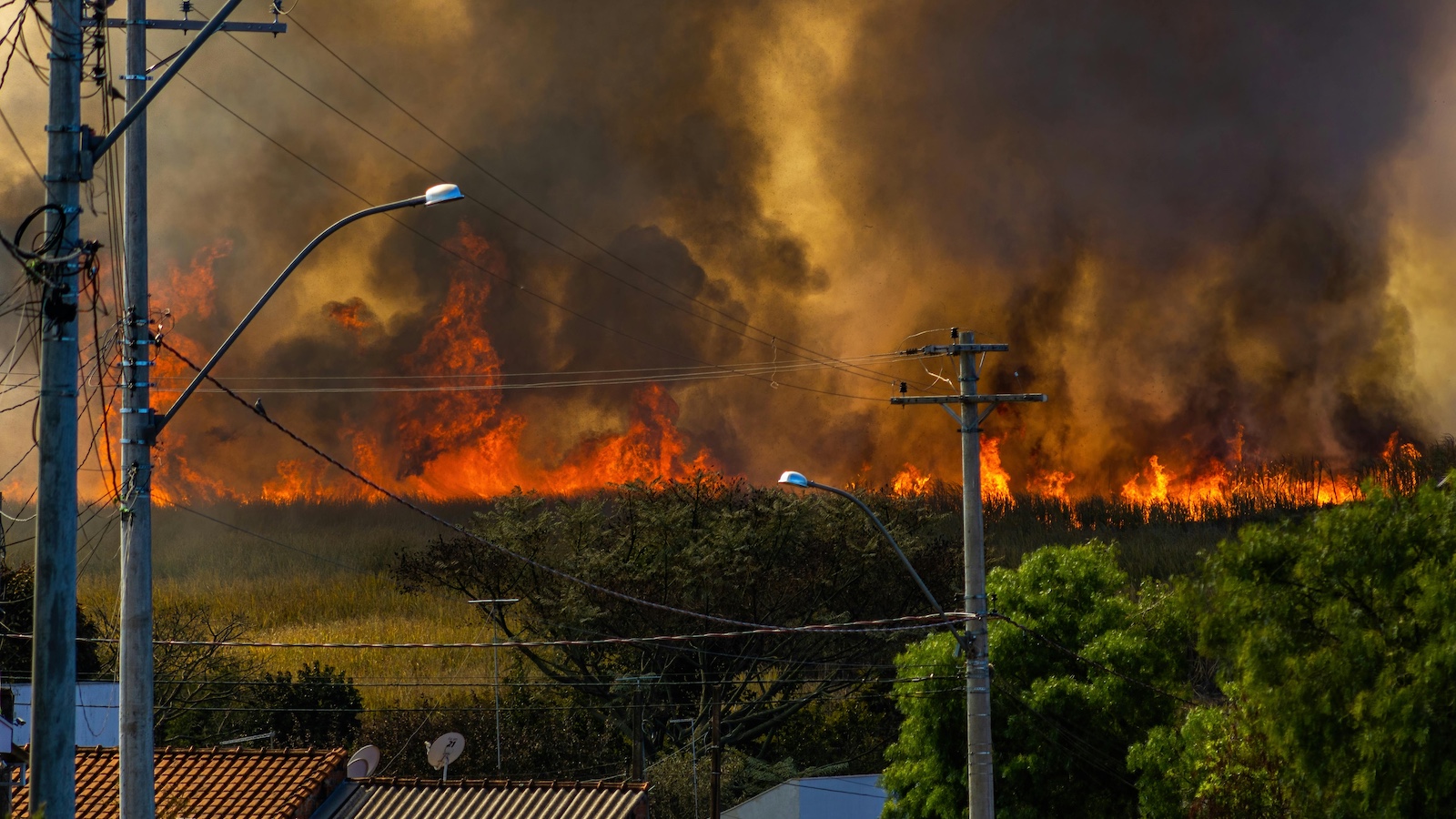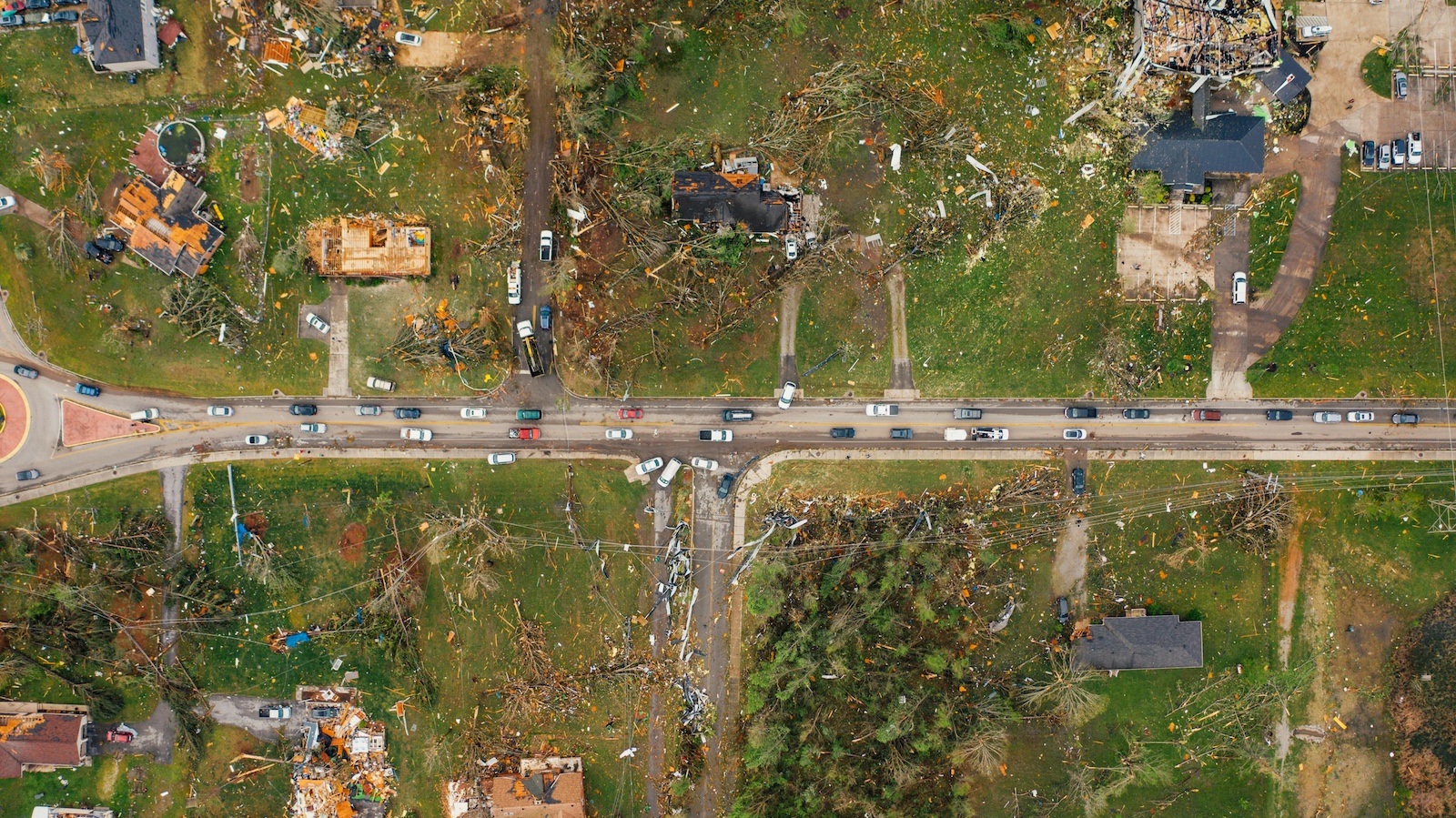Role of experience on supply of insurance
When insurers have experienced significant losses from a particular extreme event, there is a tendency for them to focus on worst-case scenarios without adequately considering their likelihood. In some instances, because of extreme losses from hurricanes, floods, earthquakes and terrorist attacks, insurers determined that they could not continue to market coverage in the U.S. without involvement by the public sector. In these situations, either the state or federal government stepped in to fill the void.
Hurricane wind-related losses
Following catastrophic wind losses from hurricanes in Florida, insurers felt they had to significantly raise their homeowners’ premiums. Rather than using catastrophe models to justify rate increases, insurers pointed to their large losses following Hurricane Andrew in 1992 as a basis for demanding higher premiums, without considering the likelihood of another disaster of this magnitude. The insurers were denied these rate increases and reduced their supply of new homeowners’ policies.
By the beginning of 2004, most insurers viewed their Florida rates as being close to adequate except in the highest-risk areas. However, after four major hurricanes battered Florida in 2004 and two more in 2005, many insurers again began to file for major premium increases, and many of them were denied, or approved at lower increases by the regulators. In 2007, the Florida Office of Insurance Regulation (FLOIR) took a position against any further rate increases of homeowners’ insurers and denied requests by all insurers. In December 2008, State Farm asked for a 67% increase in premiums that was denied by the FLOIR, leading the insurer to announce that it would no longer offer homeowners’ coverage in Florida. Five years later (March 2014), State Farm announced that it would again begin offering homeowners and renters insurance in the state on a limited basis.
Flood insurance
Following the severe Mississippi floods of 1927 and continuing through the 1960s, there was a widespread belief among private insurance companies that the flood peril was uninsurable by the private sector for several reasons: Adverse selection would be a problem because only particular areas are subject to the risk; risk-based premiums would be so high that no one would be willing to pay them; and flood losses could be so catastrophic as to cause insolvencies or have a significant impact on surplus. This lack of coverage by the private sector triggered significant federal disaster relief to victims of Hurricane Betsy in 1965 and led to the creation of the NFIP in 1968.
The NFIP subsidized premiums to maintain property values on structures in flood-prone areas; new construction was charged premiums reflecting risk. Even though premiums on existing property were highly subsidized, relatively few homeowners purchased coverage, leading the U.S. Congress to pass the Flood Disaster Protection Act (FDPA) of 1973. This bill required all properties receiving federally backed mortgages to purchase flood insurance. The NFIP has grown extensively in the past 40 years; as of January 2015, it had sold more than 5.2 million policies in 22,000 communities and provided almost $1.3 trillion in coverage. Insurance tends to be concentrated in coastal states, with Florida and Texas alone composing nearly 40% of the entire program (in number of policies, premiums and coverage). After making claims payments from Hurricane Katrina in 2005, the NFIP found itself $18 billion in debt, so that its borrowing authority had to be increased from $1.5 billion to $20.78 billion. To date, the program has borrowed nearly $27 billion from the U.S. Treasury to meet its claims obligations in the aftermath of the 2004, 2005, 2008 and 2012 hurricane seasons.
In July 2012 (three months before Hurricane Sandy), Congress passed and the president signed the Biggert–Waters Flood Insurance Reform Act of 2012 (BW12), which applied the tools of risk management to the increasingly frequent threat of flooding. Among its many provisions, the legislation required that the NFIP produce updated floodplain maps, strengthen local building code enforcement, remove insurance subsidies for certain properties and move toward charging premiums that reflect flood risk.
Soon after becoming law, BW12 faced significant challenges from some homeowners who had reason to complain that the new flood maps overestimated their risk. These residents and other homeowners in flood-prone areas felt that their proposed premium increases were unjustified and that they could not afford the increased premiums that they would face. In March 2014, Congress passed the Homeowner Flood Insurance Affordability Act (HFIAA14), which required the Federal Emergency Management Agency (FEMA) that operates the NFIP to draft an affordability framework based on the recommendations of a National Academy of Sciences’ study that addresses the affordability of flood insurance premiums.
Earthquake insurance
Until the San Fernando earthquake of 1971, few homeowners and businesses in California had purchased earthquake insurance even though coverage had been available since 1916. In 1985, the California legislature passed a law requiring insurers writing homeowners’ policies on one- to four-family units to offer earthquake insurance to these residents. The owners did not have to buy this coverage; the insurers only had to offer it. At that time and still today, banks and financial institutions do not require earthquake insurance as a condition for a mortgage.
The Northridge earthquake of January 1994 caused insured losses of $20.6 billion, primarily to commercial structures. In the three years following Northridge, demand for earthquake insurance by homeowners increased 19% in 1994, 20% in 1995 and 27% in 1996, leading private insurance companies in California to re-evaluate their seismic risk exposures. Insurers concluded that they would not sell any more policies on residential property, as they were concerned about the impact of another catastrophic earthquake on their balance sheets. The California Insurance Department surveyed insurers and found that as many as 90% of them had either stopped or had placed restrictions on the selling of new homeowners’ policies. This led to the formation of a state-run earthquake insurance company—the California Earthquake Authority (CEA)—in 1996.
Terrorism insurance
Following the terrorist attacks of 9/11, most insurers discontinued offering terrorism coverage given the refusal of global reinsurers to provide them with protection against severe losses from another attack. The few that did provide insurance charged extremely high premiums to protect themselves against a serious loss. Prior to 9/11, Chicago’s O’Hare Airport had $750 million of terrorism insurance coverage at an annual premium of $125,000. After the terrorist attacks, insurers offered the airport only $150 million of coverage at an annual premium of $6.9 million. This new premium, if actuarially fair, implies the annual likelihood of a terrorist attack on O’Hare Airport to be approximately 1 in 22 ($6.9 million/$150 million), an extremely high probability. The airport was forced to purchase this policy because it could not operate without coverage.
Concern about high premiums and limited supply of coverage led Congress to pass the Terrorism Risk Insurance Act (TRIA) at the end of 2002 that provided a federal backstop up to $100 billion for private insurance claims related to terrorism. The act was extended in 2005 for two years, in 2007 for seven years and in January 2015 for another six years, with some modification of its provisions each time the legislation was renewed.
In return for federal protection against large losses, TRIA requires that all U.S. primary insurance companies offer coverage against terrorism risk on the same terms and conditions as other perils provided by their commercial insurance policies. Firms are not required to purchase this coverage unless mandated by state law, which is normally the case for workers’ compensation insurance. TRIA also established a risk-sharing mechanism between the insurance industry, the federal government and all commercial policyholders in the U.S. for covering insured losses from future terrorist attacks.
Role of ambiguity
After 9/11, insurers determined that they could not offer terrorism insurance because the uncertainties surrounding the likelihood and consequences of another terrorist attack were so significant that the risk was uninsurable by the private sector alone. Because terrorists are likely to design their strategy as a function of their own resources and their knowledge of the vulnerability of the entity they want to attack, the nature of the risk is continuously evolving. This dynamic uncertainty makes the likelihood of future terrorist events extremely difficult to estimate.
Empirical evidence based on surveys of underwriters reveals that insurers will set higher premiums when faced with ambiguous probabilities and uncertain losses than for a well-specified risk. Underwriters of primary insurance companies and reinsurance firms were surveyed about the prices they would charge to insure a factory against property damage from a severe earthquake when probabilities and losses were well specified and when the probabilities and losses were ambiguous. The premiums the underwriters charged for the ambiguous case were 1.43–1.77 times higher than if underwriters priced a precise risk.
A recent web-based experiment provided actuaries and underwriters in insurance companies with scenarios in which they seek advice and request probability forecasts from different groups of experts and then must determine what price to charge for coverage for flood damage and wind damage from hurricanes. The average premiums that insurers would charge was approximately 30% higher for coverage against either of these risks if the probability of damage was ambiguous rather than well-specified and if the experts were conflicted over their estimates. The data reveal that they would likely charge more in the case of conflict ambiguity (i.e., experts disagree on point estimates) than imprecise ambiguity (i.e., experts agree on a range of probability, recognizing that they cannot estimate the probability of the event precisely).
Impact of intuitive thinking on regulator behavior
Rate regulation and restriction on coverage has had more impact on property insurance than on any other line of coverage, particularly in states that are subject to potentially catastrophic losses from natural disasters.
Homeowners’ insurance in Florida
Following Hurricane Andrew in August 1992, Florida regulators imposed a moratorium on the cancellation and nonrenewal of homeowners’ insurance policies during the coming hurricane season for insurers that wanted to continue to do any business in Florida. In November 1993, the state legislature enacted a bill that these insurers could not cancel more than 10% of their homeowners’ policies in any county in Florida in one year and not cancel more than 5% of their property owners’ policies statewide for each of the next three years. During the 1996 legislative session, this phase-out provision was extended until June 1, 1999.
Early in 2007, Florida enacted legislation that sought to increase regulatory control over rates and roll them back based on new legislation that expanded the reinsurance coverage provided by the Florida Hurricane Catastrophe Fund (FHCF). Insurers were required to reduce their rates to reflect this expansion of coverage, which was priced below private reinsurance market rates. This requirement applies to every licensed insurer even if an insurer does not purchase reinsurance from the FHCF.
Citizens Property Insurance Corp., Florida’s state-funded company, was formed in 2002 and has experienced a significant increase in market share of the residential property market in recent years. Consumers are allowed to purchase a policy from Citizens if a comparable policy would cost 15% more in the private market. The most serious defect of such a system is that it encourages individuals to locate in high-hazard areas, thus putting more property at risk than would occur under a market system. This is the principal reason not to introduce such a system in the first place. Since 2005, there have been no hurricanes causing severe damage in Florida. But should there be a serious disaster that depletes Citizens’ reserves, the additional claims are likely to be paid from assessments (taxes) charged to all homeowners in Florida.
Earthquake insurance in California
As pointed out earlier, when insurers refused to continue to offer earthquake insurance in California, the state formed the CEA. The CEA set the premiums in many parts of the state at higher levels than insurers had charged prior to the Northridge earthquake of 1994. At the same time, the minimum deductible for policies offered through the CEA was raised from 10% to 15% of the insured value of the property. There was no consideration by the state insurers as to how this change would affect the demand for coverage.
This increased price/reduced coverage combination was not especially attractive to homeowners in the state. A 15% deductible based on the amount of coverage in place is actually quite high relative to damages that typically occur. Most homes in California are wood-frame structures that would likely suffer relatively small losses in a severe earthquake. For example, if a house was insured at $200,000, a 15% deductible implies that the damage from the earthquake would have to exceed $30,000 before the homeowner could collect a penny from the insurer. Given that only 10% of homeowners in California have quake insurance today, if a major earthquake were to occur in California next year so that many homes were partially damaged, the uninsured losses could be very high. It is surprising that there has been little interest by private insurers in offering earthquake coverage at competing or lower rates to those offered by the CEA, even though there is no regulation preventing them from doing so.
GUIDING PRINCIPLES
The following two guiding principles should enable insurance to play a more significant role in the management and financing of catastrophic risks.
Principle 1—Premiums should reflect risk
Insurance premiums should be based on risk to provide individuals with accurate signals as to the nature of the hazards they face and to encourage them to engage in cost-effective mitigation measures to reduce their vulnerability. Risk-based premiums should also reflect the cost of capital that insurers need to integrate into their pricing to ensure an adequate return to their investors.
Catastrophe models have been developed and improved over the past 25 years to more accurately assess the likelihood and damages resulting from disasters of different magnitudes and intensities. Today, insurers and reinsurers use the estimates from these models to determine risk-based premiums and how much coverage to offer in hazard-prone areas.
If Principle 1 is applied to risks where premiums are currently subsidized, some residents will be faced with large price increases. This concern leads to the second guiding principle.
Principle 2—Dealing with equity and affordability issues
Any special treatment given to low-income individuals currently residing in hazard-prone areas should come from general public funding and not through insurance premium subsidies. Funding could be obtained from several different sources such as general taxpayer revenue or state government or by taxing insurance policyholders depending on the response to the question, “Who should pay?” It is important to note that Principle 2 applies only to those individuals who currently reside in hazard-prone areas. Those who decide to locate in these regions in the future would be charged premiums that reflect the risk.
Developing long-term strategies for dealing with extreme events
Given the nature of intuitive thinking for LP-HC events, this section proposes strategies for applying the two guiding principles so that insurance in combination with other policy tools can reduce future losses from extreme events. The proposed risk management strategy involves:
- Choice architecture to frame the problem so that the risks are transparent and key interested parties recognize the importance of purchasing and maintaining insurance while also undertaking protective measures to reduce their losses from the next disaster.
- Public–private partnerships to assist those who cannot afford to invest in protective measures and to provide financial protection against catastrophic losses for risks that are considered uninsurable by the private sector alone.
- Multi-year insurance to provide premium stability to policyholders and lower marketing costs to insurers and to reduce cancellation of coverage by those at risk.
Choice architecture
The term choice architecture, coined by Thaler and Sunstein, indicates that people’s decisions often depend in part on how different options are framed and presented. Framing in the context of LP-HC events typically refers to the way in which likelihoods and outcomes are characterized. One can also influence decisions by varying the reference point or by changing the order in which alternatives or their attributes are presented, or by setting one option as the no-choice default option.
Framing the risk
People are better able to evaluate low-probability risks when these are presented via a familiar concrete context. For example, individuals might not understand what a one-in-a-million risk means but can more accurately interpret this figure when it is compared to the annual chance of dying in an automobile accident (1-in-6,000) or lightning striking your home on your birthday (less than one in a billion).
Probability is more likely to be a consideration if it is presented using a longer time frame. People are more willing to wear seat belts if they are told they have a 1-in-3 chance of an accident over a 50-year lifetime of driving, rather than a 1-in-100,000 chance of an accident on each trip they take. Similarly, a homeowner or manager considering earthquake protection over the 25-year life of a home or factory is far more likely to take the risk seriously if told that the chance of at least one severe earthquake occurring during this time is greater than 1-in-5, rather than 1-in-100 in any given year.
Studies have shown that even just multiplying the single-year risk so the numerator is larger— presenting it as 10-in-1,000 or 100-in-10,000 instead of 1-in-100—makes it more likely that people will pay attention to the event. Studies have also found that comparisons of risks— rather than just specifying the probability of a loss or an insurance premium—are much more effective in helping decision-makers assess the need for purchasing insurance.
Another way to frame the risk so that individuals pay attention is to construct a worst-case scenario. Residents in hazard-prone areas who learn about the financial consequences of being uninsured if they were to suffer severe damage from a flood or earthquake would have an incentive to purchase insurance coverage and may refrain from canceling their insurance if they have not made a claim for a few years. One could then provide them with information on the likelihood of the event occurring over the next 25 years rather than just next year.
Insurers could also construct worst-case scenarios and then estimate the likelihood of the event’s occurrence when pricing their insurance policies. They could then determine a premium that reflects their best estimate of their expected loss while at the same time factoring in the uncertainty surrounding the risk.
Default options
Field and controlled experiments in behavioral economics reveal that consumers are more likely to stick with the default option rather than going to the trouble of opting out in favor of some alternative. Many examples of this behavior are detailed in Thaler and Sunstein’s important book,
Nudge. To date, this framing technique has been applied to situations where the outcome is either known with certainty, or when the chosen option (such as a recommended 401(k) plan), has a higher expected return than the other options. It is not clear whether people who failed to purchase coverage would reverse course if having insurance against an extreme event was the default option, given the intuitive thinking that individuals employ for these types of risks. More empirical research is needed to more fully understand the role that default options can play with respect to encouraging insurance protection for LP-HC events.
Public–private partnerships
Individuals at risk may be reluctant to invest in cost-effective loss reduction measures when these involve a high, upfront cash outlay. Given budgetary constraints and individuals’ focus on short time horizons, it is difficult to convince them that the expected discounted benefits of the investment over the expected life of the property exceeds the immediate upfront cost. Decision-makers’ resistance is likely to be compounded if they perceive the risk to be below their threshold level of concern. Residents in hazard-prone areas may also be concerned that, if they move in the next few years, the property value of their home will not reflect the expected benefits from investing in loss reduction measures because the new owner will not be concerned about the risk of a disaster.
Mitigation grants and loans
FEMA created the Flood Mitigation Assistance (FMA) program in 1994 to reduce flood insurance claims. FMA is funded by premiums received by the NFIP to support loss reduction measures, such as elevation or relocation of property, flood-proofing commercial structures or demolition and rebuilding of property that has received significant damage from a severe flood.
In July 2014, Connecticut initiated its Shore Up CT program designed to help residential or business property owners elevate buildings or retrofit properties with additional flood protection, or assist with wind-proofing structures on property that is prone to coastal flooding. This state program, the first in the U.S., enables homeowners to obtain a 15-year loan ranging from $10,000 to $300,000 at an annual interest rate of 2 3⁄4%.
More generally, long-term loans to homes and businesses for mitigation would encourage individuals to invest in cost-effective risk-reduction measures. Consider a property owner who could pay $25,000 to elevate his coastal property from three feet below Base Flood Elevation (BFE) to one foot above BFE to reduce storm surge damage from hurricanes. If flood insurance is risk-based, then the annual premium would decrease by $3,480 (from $4,000 to $520). A 15-year loan for $25,000 at an annual interest rate of 2 3⁄4% would result in annual payments of $2,040 so that the savings to the homeowner each year would be $1,440 (that is, $3,480−$2,040).
Means-tested vouchers
One way to maintain risk-based premiums while at the same time addressing issues of affordability is to offer means-tested vouchers that cover part of the cost of insurance. Several existing programs could serve as models for developing such a voucher system: the Food Stamp Program, the Low Income Home Energy Assistance Program (LIHEAP) and Universal Service Fund (USF). The amount of the voucher would be based on current income and determined by a specific set of criteria as outlined in the National Research Council’s report on the affordability of flood insurance. If the property owners were offered a multi-year loan to invest in mitigation measure(s), the voucher could cover not only a portion of the resulting risk-based insurance premium, but also the annual loan cost to make the package affordable. As a condition for the voucher, the property owner could be required to invest in mitigation.
An empirical study of homeowners in Ocean county, NJ, reveals that the amount of the voucher is likely to be reduced significantly from what it would have been had the structure not been mitigated, as shown in Figure 2 for property in a high-hazard flood area (the V Zone) and a lower-hazard area (the A Zone).

Catastrophe coverage
Insurers’ withdrawal from certain markets because of lack of reinsurance capacity and other risk transfer instruments (e.g. catastrophe bonds) led to the establishment of government-backed programs such as the CEA, NFIP and TRIA.
If insurers were permitted to charge risk-based premiums, they would very likely want to market coverage against earthquakes and floods as long as they were protected against catastrophic losses. State reinsurance facilities could play an important role in this regard if premiums were risk-based using data provided by catastrophe models. One such facility exists today—the FHCF. It was established in 1993 following Hurricane Andrew to supplement private reinsurance and reimburse all insurers for a portion of their losses from catastrophic hurricanes.
TRIA provides protection to insurers against catastrophic losses from future terrorist attacks. American taxpayers will not be responsible for any payments until the total commercial losses from a terrorist attack exceed $60 billion. In other words, insurers will cover the entire losses from future terrorist attacks that are not catastrophic.
Lewis and Murdock proposed that the federal government auction a limited number of catastrophe reinsurance contracts annually to private insurers to provide them with more capacity to handle truly extreme events. The design of such contracts would have to be specified, and a more detailed analysis would have to be undertaken to determine the potential impact of such an auction mechanism on the relevant stakeholders.
Well-enforced regulations and standards
Given the reluctance of individuals to voluntarily purchase insurance against losses, one should consider requiring catastrophic coverage for all individuals who face risk. Social welfare is likely to be improved under the assumption that individuals would have wanted insurance protection had they perceived the risk correctly, not exhibited systematic biases and used simplified decision rules that characterize intuitive thinking. If the public sector were providing protection against catastrophic losses from these extreme events, they could pass regulations requiring insurance coverage for individuals at risk.
Risk-based insurance premiums could be coupled with building codes so that those residing in hazard-prone areas adopt cost-effective loss-reduction measures. Following Hurricane Andrew in 1992, Florida re-evaluated its building code standards, and coastal areas of the state began to enforce high-wind design provisions for residential housing. As depicted in Figure 3, homes that met the wind-resistant standards enforced in 1996 had a claim frequency that was 60% less than that for homes that were built prior to that year. The average reduction in claims from Hurricane Charley (2004) to each damaged home in Charlotte County built according to the newer code was approximately $20,000.
Homeowners who adopt cost-effective mitigation measures could receive a seal of approval from a certified inspector that the structure meets or exceeds building code standards. A seal of approval could increase the property value of the home by informing potential buyers that damage from future disasters is likely to be reduced because the mitigation measure is in place. Evidence from a July 1994 telephone survey of 1,241 residents in six hurricane-prone areas on the Atlantic and Gulf Coasts provides supporting evidence for some type of seal of approval. More than 90% of the respondents felt that local home builders should be required to adhere to building codes, and 85% considered it very important that local building departments conduct inspections of new residential construction.
 Multi-year insurance
Multi-year insurance
As a complement to property improvement loans, insurers could consider designing multi-year insurance (MYI) contracts of three to five years. The insurance policy would be tied to the structure rather than the property owner and carry an annual premium reflecting risk that would remain stable over the length of the contract. Property owners who cancel their insurance policy early would incur a penalty cost in the same way that those who refinance a mortgage have to pay a cancellation cost to the bank issuing the mortgage. With an MYI contract, insurers would have an incentive to inspect the property over time to make sure that building codes are enforced, something they would be less likely to do with annual contracts.
To compare the expected benefits of annual vs multi-year contracts, Jaffee et al. developed a two-period model where premiums reflect risk in a competitive market setting. They show that an MYI policy reduces the marketing costs for insurers over one-period policies and also eliminates the search costs to policyholders should their insurer decide to cancel their coverage at the end of period 1. Should the policyholder learn that the cost of a one-period policy is sufficiently low to justify paying a cancellation cost, it is always optimal for the insurer to sell an MYI policy and for a consumer to purchase it. The insurer will set the cancellation cost at a level that enables it to break even on those policies that the insured decides to let lapse before the maturity date.
Several factors have contributed to the non-marketability of MYI for protecting homeowners’ properties against losses from fire, theft and large-scale natural disasters. Under the current state-regulated arrangements in which many insurance commissioners have limited insurers’ ability to charge risk-based premiums in hazard-prone areas, no insurance company would even entertain the possibility of marketing a homeowner’s policy that was longer than one year. Insurers would be concerned about the regulator clamping down on them now or in the future regarding what price they could charge. Uncertainty regarding costs of capital and changes in risk over time may also deter insurers from providing MYI.
For the private sector to want to market coverage if the above issues are addressed, there needs to be a sufficient demand to cover the fixed and administrative costs of developing and marketing the product. To empirically test the demand for MYI, a web- based experiment was undertaken with adults in the U.S.; most were older than 30 years, so they were likely to have experience purchasing insurance. The individuals participating in the experiment were offered a choice between one-year and two-year contracts against losses from hurricane-related damage. A large majority of the responders preferred the two-year contract over the one-year contract, even when it was priced at a higher level than the actuarially fair price. Introducing a two-year insurance policy into the menu of contracts also increased the aggregate demand for disaster insurance.
Modifying the National Flood Insurance Program
The NFIP provides a target of opportunity to implement a long-term strategy for reducing risk that could eventually be extended to other extreme events. The two guiding principles for insurance would be used in redesigning the rate structure for the program:
- Premiums would reflect risk based on updated flood maps so that private insurers would have an incentive to market coverage.
- Means-tested vouchers would be provided by the public sector to those who undertook cost-effective mitigation measures. This would address the affordability issue. Homeowners who invested in loss-reduction measures would be given a premium discount to reflect the reduction in expected losses from floods. Long-term loans for mitigation would encourage investments in cost-effective mitigation measures. Well-enforced building codes and seals of approval would provide an additional rationale for undertaking these loss-reduction measures.
- An MYI policy tied to the property would deter policyholders from canceling their policies if they did not suffer losses for several years.
- Reinsurance and risk-transfer instruments marketed by the private sector could cover a significant portion of the catastrophic losses from future floods. Some type of federal reinsurance would provide insurers with protection against extreme losses.
The social welfare benefits of this proposed program would be significant: less damage to property, lower costs to insurers for protecting against catastrophic losses, more secure mortgages and lower costs to the government for disaster assistance.
Directions for future studies and research
In theory, insurance rewards individuals who undertake loss reduction measures by lowering their premiums. For insurance to play this role, premiums have to reflect risk; otherwise, insurers will have no financial incentive to offer coverage or will not want to reduce premiums when those at risk undertake protective measures. Charging risk-based premiums raises questions of affordability for those low-income residents in hazard-prone areas who are currently paying subsidized prices for coverage or have elected to be uninsured because of budget constraints or misperceptions of the risk. In addition, insurers may elect not to offer coverage if they are concerned about the impact that catastrophic losses will have on their balance sheet as evidenced by their decisions not to offer flood, earthquake or terrorism insurance in the U.S. without some type of back-up from the state or federal government. To determine the price of risk-based premiums, there is a need for more accurate data. In the U.S., FEMA is now updating its flood-risk maps as recommended by a Government Accountability Office (GAO) study and by recent federal legislation on the NFIP.
The impact of changing climate patterns on future damage from flooding because of potential sea-level rise and more intense hurricanes also needs to be taken into account. There is evidence that federal agencies and other bodies have underestimated the risks of damage from extreme weather events because of climate change. Hurricane Sandy has stimulated studies on ways that communities can be more prepared for future disaster damage as well as highlighting the need for a suite of policy tools including insurance to address the climate change problem.
Studies are also needed as to ways that other policy tools, such as well-enforced building codes to encourage good construction practices, can complement insurance. Enforcing building codes for all residences in Florida could reduce by nearly half the risk-based prices of insurance under climate change projections with respect to hurricane damage in 2020 and 2040. In this regard, Chile serves an example for the U.S. to emulate. The country passed a law that requires the original construction company to compensate those who suffer any structural damage from earthquakes and other disasters if the building codes were not followed. Furthermore, the original owner of a building is held responsible for damage to the structure for a decade, and a court can sentence the owner to prison. Well-enforced building codes in Chile account for the relatively low death toll from the powerful earthquake (8.8 on moment magnitude scale) that rocked the country on Feb. 27, 2010.
The challenge facing the U.S. today is how to capitalize on the concerns raised by hurricanes Katrina and Sandy and discussions on the renewal of the NFIP in 2017. The case for making communities more resilient to natural disasters by investing in loss reduction measures is critical today given economic development in hazard-prone areas. For risk-based insurance to be part of such a strategy, there is a need for support from key interested parties. These include the real estate agents, developers, banks and financial institutions, residents in hazard-prone areas and public sector organizations at the local, state and federal levels.
The principle of risk-based premiums coupled with concerns regarding affordability and catastrophic losses apply to all countries that use insurance as a policy tool for dealing with risk. Studies on the role that the private and public sectors play with respect to risk sharing of these losses reveal significant differences between countries. Other countries face similar problems and would do well to consider how to develop long-term strategies that have a chance of being implemented because they address short-term concerns.

 DECISION PROCESSES
DECISION PROCESSES

 Multi-year insurance
Multi-year insurance








